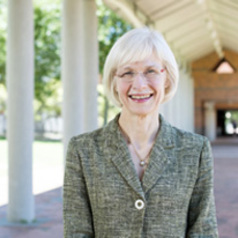This is an edited extract of a speech to the National Press Club given by Chair of Universities Australia, Professor Deborah Terry AO
New modelling for Universities Australia prepared by Ernst and Young finds close to 17,000 companies in Australia collaborated with a university last year.
That’s a 5% jump in two years. The direct benefit to those businesses from collaboration with universities was A$12.8 billion in 2018-2019. To put it plainly – that’s a return of almost A$4.50 to business for each one dollar invested in collaborative research with a university.
The overall boost that this collaborative activity gives the nation’s economy is now estimated at A$26.5 billion.
We’ve seen first-hand the difference it can make to industry. Just ask mango farmer Ian Groves from near Yeppoon in central Queensland. Thanks to Professor Kerry Walsh, from CQ University’s Institute for Future Farming Systems, the mango industry has been transformed.
His university team developed infrared technology that can scan each mango while it’s still on the tree. The technology can count mangoes, assess their ripeness, and project the perfect time for picking to maximise both flavour and shelf life.
And that saves costs – because farmers know when and how many boxes to order, when to hire pickers, and how to get more fruit to market in top condition.
University precincts breathe life into local and regional economies. They’re a shot in the arm for industry. I’ve seen this first-hand both here and abroad.
In the United States, when you visit MIT and Boston, it’s hard to tell where one ends and the other begins.
The same is true for Australian precincts.
In Sydney’s inner-west, the South Eveleigh innovation precinct houses start-up tech firms and spin-offs from uni research. Further west, you’ll find the Agripark in Richmond and the Westmead health precinct. Further west again, you’ll find Lot 14 in Adelaide, now home to the Australian Space Agency, and seriously further west, the Murdoch Health and Knowledge Precinct.
Down south, there are increasingly dense footprints of industry partners around the Universities of Melbourne and Monash. And up north, in Queensland, you’ll find the Ecosciences Precinct and the Translational Research Institute.
And the list goes on.
[…]
So today I want to reiterate our offer to Australian businesses and industry. If you have a business challenge you haven’t been able to crack, ask us to help. The nation’s universities stand ready, willing and able to work with you.
And we have deep expertise to bring to your challenges. We’re reaching out. We want business to reach in. We’re making progress, but we can do more together.
In a speech last year, Professor Alison Wolf of Kings College London, noted that universities are enormously long-lived and successful compared to almost all other institutions in society. And far longer lived than, say, a random sample of companies from the Fortune 500.
Wolf concludes that as long as R&D keeps generating new ideas and helping growth, the modern university sector will continue to be supported by the state. And she notes more and more people rationally want to go to university so it’s hard for governments to pull the plug on such access for voting citizens.
Which is why we are so committed to working collaboratively with government to address the shared challenges on the horizon. To ensure that as our population grows, our young people have the same access to university education as those who came before them.
To close the education gaps that still exist in our regional communities, in our outer suburbs and in our Indigenous communities. To deliver the skilled graduate labour force that is so essential if our economy is to continue to grow and to diversify.
And to play our role to help shape the future through our education, our research and our innovation.



 HyperLiquid's Bold Moves: Staking Feature and Whale Investments Propel HYPE Forward
HyperLiquid's Bold Moves: Staking Feature and Whale Investments Propel HYPE Forward  Biden Administration Pauses Enforcement of Nippon Steel’s Bid for U.S. Steel
Biden Administration Pauses Enforcement of Nippon Steel’s Bid for U.S. Steel  European Share Buybacks Poised for Growth in 2025
European Share Buybacks Poised for Growth in 2025  Japan-U.S. Relations Steady Despite Nippon Steel Merger Block
Japan-U.S. Relations Steady Despite Nippon Steel Merger Block  Southern California is extremely dry, and that’s fueling fires − maps show just how dry
Southern California is extremely dry, and that’s fueling fires − maps show just how dry  BlackRock Seeks FDIC Oversight Deadline Extension to March
BlackRock Seeks FDIC Oversight Deadline Extension to March  Rising Bond Yields Pose Risks to US Stocks and Boost Dollar
Rising Bond Yields Pose Risks to US Stocks and Boost Dollar  US Payroll Surge Delays Federal Reserve Rate Cuts
US Payroll Surge Delays Federal Reserve Rate Cuts  Solana's Meteoric Rise: Price Trends, Whale Accumulation, and Future Predictions
Solana's Meteoric Rise: Price Trends, Whale Accumulation, and Future Predictions  Gold Soars as Safe-Haven Demand Surges Amid Rising U.S. Treasury Yields and Strong Jobs Data
Gold Soars as Safe-Haven Demand Surges Amid Rising U.S. Treasury Yields and Strong Jobs Data  Gold's Fortitude Tested: Economic Signals and USD Strength Shape Market Outlook
Gold's Fortitude Tested: Economic Signals and USD Strength Shape Market Outlook  Gold Soars Amid Tariff Woes: Market Dynamics and Labor Trends Unfold
Gold Soars Amid Tariff Woes: Market Dynamics and Labor Trends Unfold 































